Direction (1-5): The question given below consists of some statements given below it. You have to decide whether the data provided in the statements are sufficient to answer the question. Read all the statements and give answer.
Q1. Six boxes A, B, C, D, E and F are kept one above the other like a stack. The bottommost box is numbered as 1 and the topmost box is numbered as 6. Which box is the topmost box?
Statements:
I. D is immediately above A. E is three boxes above B. A is three boxes above C.
II. At most two boxes are above E. D is three boxes above F. C is immediately above B.
III. A is at least two boxes above C. F is not above A.
(a) Data given in both statements II and III are together sufficient to answer.
(b) Data given in both statements I and II are together sufficient to answer.
(c) Data given in both statements I and III are together sufficient to answer.
(d) Data given in all three statements I, II and III are together sufficient to answer.
(e) Data given in all three statements I, II and III are not together sufficient to answer.
Q2. Seven persons S, T, U, V, W, X and Y sit around a circular table facing outside the centre of the table. What is the position of W with respect to S?
Statements:
I. X sits 2nd to the left of V. Y is 2nd to the left of S. W doesn’t sit adjacent to Y.
II. Two persons sit between V and S. U sits 2nd to the right of T. W doesn’t sit 2nd to the right of U.
III. Three persons sit between X and T. One person sits between T and W.
(a) Data given in both statements II and III are together sufficient to answer.
(b) Data given in both statements I and II are together sufficient to answer.
(c) Data given in both statements I and III are together sufficient to answer.
(d) Data given in all three statements I, II and III are together sufficient to answer.
(e) Data given in all three statements I, II and III are not together sufficient to answer.
Q3. Seven persons P, Q, R, S, T, U and V have different weights. Who is the 2nd heaviest person?
Statements:
I. At least three persons are heavier than P. Q is heavier than S and U. T and V are not the lightest person. P is heavier than R.
II. More than one person is lighter than R. S is lighter than at most three persons. Q is not the heaviest person.
III. U is not heavier than P. At least two persons are heavier than R.
(a) Data given in both statements II and III are together sufficient to answer.
(b) Data given in both statements I and II are together sufficient to answer.
(c) Data given in both statements I and III are together sufficient to answer.
(d) Data given in all three statements I, II and III are together sufficient to answer.
(e) Data given in all three statements I, II and III are not together sufficient to answer.
Q4. Seven bases (A, B, C, D, E, F and G) are placed one above the other, such that bottommost box is numbered as 1 and topmost box is numbered as 7. How many boxes are placed above E?
Statements:
I. Three boxes are placed between A and D which is placed just below E. Three boxes are placed between G and E. G is an even numbered box.
II. C is 7th box. Two boxes are placed between C and F. Only one box is placed between E and F.
III. B is placed below F. G is not placed above B.
(a) Data given in both statements II and III are together sufficient to answer.
(b) Data given in both statements I and II are together sufficient to answer.
(c) Data given in both statements I and III are together sufficient to answer.
(d) Data given in all three statements I, II and III are together sufficient to answer.
(e) Data given in all three statements I, II and III are not together sufficient to answer.
Q5. Six children (M, N, O, P, Q, and R) sit in park at different distances and directions with respect to each other. What is the direction of O with respect to R?
Statements:
I. N sits 15m west of M who sits 7m north of R. P sits 12m east of M who sits 8m south of Q. O sits 11m west of Q.
II. R sits 15m south of Q. Q sits 8m north of M. Q sits 11m east of O. N sits 27m west of P. M sits 15m east of N.
(a) The data in statement I alone are sufficient to answer the question, while the data in statement II alone are not sufficient to answer the question.
(b) The data in statement II alone are sufficient to answer the question, while the data in statement I alone are not sufficient to answer the question.
(c) The data either in statement I alone or in statement II alone are sufficient to answer the question.
(d) The data given in statements I and II together are not sufficient to answer the question.
(e) The data in statements I and II together are necessary to answer the question.
Direction (6-10): The question given below consists of two statements numbered I and II given below it. You have to decide whether the data provided in the statements are sufficient to answer the question. Read all the statements and give answer.
Q6. Eight plants M, N, O, P, Q, R, S and T are planted at certain distance from one another in a park. What is the direction of N with respect to T?
Statements:
I. M is 6m west of S. N is 5m south of S. Q is northeast of both N and S. P is 5m east of Q. R is 6m south of P. T is 9m west of R.
II. O is 7m east of N. Distance between Q and O is 8m. S is to the northwest of O. Q is to the north of O. T is southwest of Q.
(a) The data in statement I alone are sufficient to answer the question, while the data in statement II alone are not sufficient to answer the question.
(b) The data in statement II alone are sufficient to answer the question, while the data in statement I alone are not sufficient to answer the question.
(c) The data either in statement I alone or in statement II alone are sufficient to answer the question.
(d) The data given in statements I and II together are not sufficient to answer the question.
(e) The data in statements I and II together are necessary to answer the question.
Q7. Sohan bought six different things viz. Bike, Car, Laptop, Mobile, Sofa and Watch in different consecutive years starting from 2012. He bought a watch in 2013. What was bought in 2015?
Statements:
I. Only two things were bought between a watch and a laptop. The car was bought in a leap year. Bike was bought immediately after a sofa.
II. He bought a mobile in 2017 and only two things were bought between a mobile and a sofa. A car was bought before a bike which was bought before a laptop.
(a) The data in statement I alone are sufficient to answer the question, while the data in statement II alone are not sufficient to answer the question.
(b) The data in statement II alone are sufficient to answer the question, while the data in statement I alone are not sufficient to answer the question.
(c) The data either in statement I alone or in statement II alone are sufficient to answer the question.
(d) The data given in statements I and II together are not sufficient to answer the question.
(e) The data in statements I and II together are necessary to answer the question.
Q8. Six people Abhi, Anil, Dani, Kiran, Riya and Savi are living in a six floored building, floors of which are numbered 1-6 from bottom to top. Kiran lives immediately above Abhi. Who lives on the bottommost floor?
Statements:
I. Riya lives on the third floor and only one person lives between Abhi and Riya. Anil lives immediately above Dani and neither of them lives above the fourth floor.
II. Savi lives on the fourth floor and lives immediately below Abhi. Anil does not live on an odd numbered floor.
(a) The data in statement I alone are sufficient to answer the question, while the data in statement II alone are not sufficient to answer the question.
(b) The data in statement II alone are sufficient to answer the question, while the data in statement I alone are not sufficient to answer the question.
(c) The data either in statement I alone or in statement II alone are sufficient to answer the question.
(d) The data given in statements I and II together are not sufficient to answer the question.
(e) The data in statements I and II together are necessary to answer the question.
Q9. Seven friends P, Q, R, S, T, U and V were born on different days of a week which starts on Monday of the same month of the same year. U was born on Friday. Who was born on Tuesday?
Statements:
I. V was born on a Thursday and was born immediately after P. R was born immediately before S.
II. Only three people were born between U and Q. T and Q were born on adjacent days.
(a) The data in statement I alone are sufficient to answer the question, while the data in statement II alone are not sufficient to answer the question.
(b) The data in statement II alone are sufficient to answer the question, while the data in statement I alone are not sufficient to answer the question.
(c) The data either in statement I alone or in statement II alone are sufficient to answer the question.
(d) The data given in statements I and II together are not sufficient to answer the question.
(e) The data in statements I and II together are necessary to answer the question.
Q10. Ten cats A, B, C, D, E, F, G, H, I, and J are arranged in a row from left to right. Which cat is fourth to the right of B if G is at one of the extreme ends of a row?
Statements:
I. Four Cats are between A and D. B is third to the left of D. E is placed exactly between C and D. G is second to the right of C. D is an immediate neighbour of E.
II. F is fourth to the left of D. Five cats are placed between A and E.
(a) The data in statement I alone are sufficient to answer the question, while the data in statement II alone are not sufficient to answer the question.
(b) The data in statement II alone are sufficient to answer the question, while the data in statement I alone are not sufficient to answer the question.
(c) The data either in statement I alone or in statement II alone are sufficient to answer the question.
(d) The data given in statements I and II together are not sufficient to answer the question.
(e) The data in statements I and II together are necessary to answer the question.
Direction (11-15): The question given below consists of two statements numbered I and II given below it. You have to decide whether the data provided in the statements are sufficient to answer the question. Read all the statements and give answer.
Q11. Which direction is I with respect to H?
Statements:
I. H is 15m towards the east of D. A is 25 m towards the west of I. D is 20 m towards the north of A.
II. B is 25 m towards the west of H. I is 25 m towards the east of A. A is 20 m towards the south of D. D is 10 m towards the east of B.
(a) The data in statement I alone are sufficient to answer the question, while the data in statement II alone are not sufficient to answer the question.
(b) The data in statement II alone are sufficient to answer the question, while the data in statement I alone are not sufficient to answer the question.
(c) The data either in statement I alone or in statement II alone are sufficient to answer the question.
(d) The data given in statements I and II together are not sufficient to answer the question.
(e) The data in statements I and II together are necessary to answer the question.
Q12. Six persons have exams on 12th and 13th of June, July and August such that no two persons have exams on the same day. C has his exam in the month of July. Who has his exam on 12th August?
Statements:
I. M has his exam immediately before A. Two persons have exams in between D and A. S has his exam before X but not immediately.
II. D has his exam in August. Three persons have exams in between M and D. X has his exam after A. S has his exam immediately after C.
(a) The data in statement I alone are sufficient to answer the question, while the data in statement II alone are not sufficient to answer the question.
(b) The data in statement II alone are sufficient to answer the question, while the data in statement I alone are not sufficient to answer the question.
(c) The data either in statement I alone or in statement II alone are sufficient to answer the question.
(d) The data given in statements I and II together are not sufficient to answer the question.
(e) The data in statements I and II together are necessary to answer the question.
Q13. In a certain language, ‘Headphones on world off’ is coded as ‘do, me, fa, re’. What is the code for ‘off’?
Statements:
I. “Research on headphones’ is coded as ‘do re so’ and ‘World has opportunities’ is coded as ‘la, te me’.
II. ‘Headphones are off’ is coded as ‘ga do fa’ and ‘Life goes on’ is coded as ‘pa, ka, re’.
(a) The data in statement I alone are sufficient to answer the question, while the data in statement II alone are not sufficient to answer the question.
(b) The data in statement II alone are sufficient to answer the question, while the data in statement I alone are not sufficient to answer the question.
(c) The data either in statement I alone or in statement II alone are sufficient to answer the question.
(d) The data given in statements I and II together are not sufficient to answer the question.
(e) The data in statements I and II together are necessary to answer the question.
Q14. There are five cars (P, Q, R, S and T), which are parked in a row and face in north direction. Which car is parked immediate right of car P?
Statements:
I. Car P is parked immediate right of car T. Car P is parked second to the left of car Q which is not parked at any end of the row. Car R is parked to the right of car S.
II. Car S is parked in middle of the row. Car Q and car R are immediate neighbors. Car P and car Q are parked to the right of car T.
(a) The data in statement I alone are sufficient to answer the question, while the data in statement II alone are not sufficient to answer the question.
(b) The data in statement II alone are sufficient to answer the question, while the data in statement I alone are not sufficient to answer the question.
(c) The data either in statement I alone or in statement II alone are sufficient to answer the question.
(d) The data given in statements I and II together are not sufficient to answer the question.
(e) The data in statements I and II together are necessary to answer the question.
Q15. There are five children (A, B, C, D and E) having different heights, who is the second tallest child?
Statements:
I. C is taller than A but shorter than E. B is taller than C but shorter than D.
II. E is shorter than D but taller than A. C is shorter than D. B is not the tallest person.
(a) The data in statement I alone are sufficient to answer the question, while the data in statement II alone are not sufficient to answer the question.
(b) The data in statement II alone are sufficient to answer the question, while the data in statement I alone are not sufficient to answer the question.
(c) The data either in statement I alone or in statement II alone are sufficient to answer the question.
(d) The data given in statements I and II together are not sufficient to answer the question.
(e) The data in statements I and II together are necessary to answer the question.
Solutions
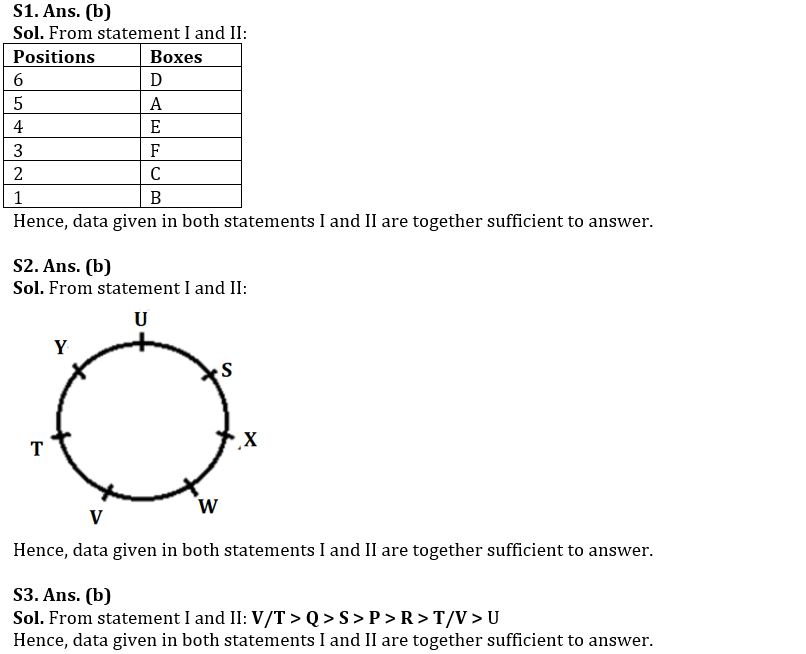
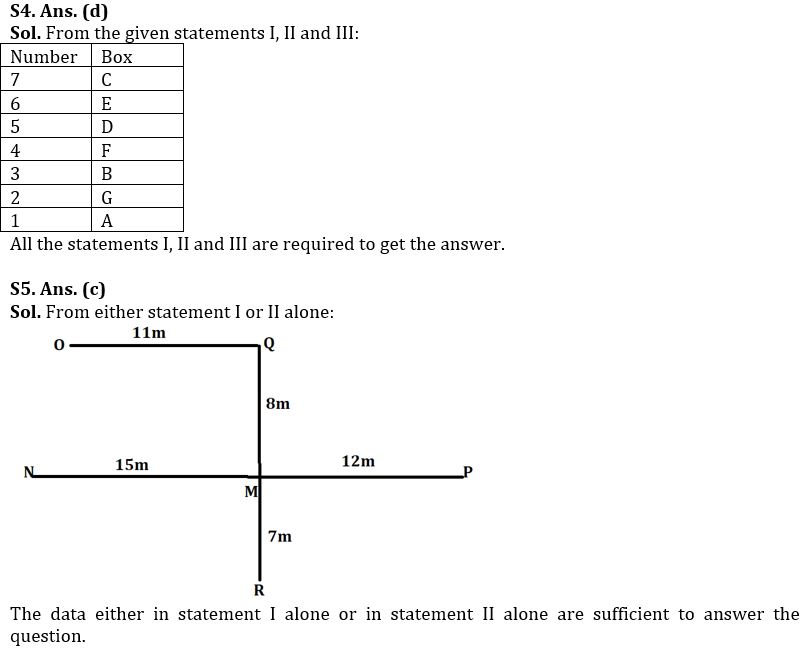
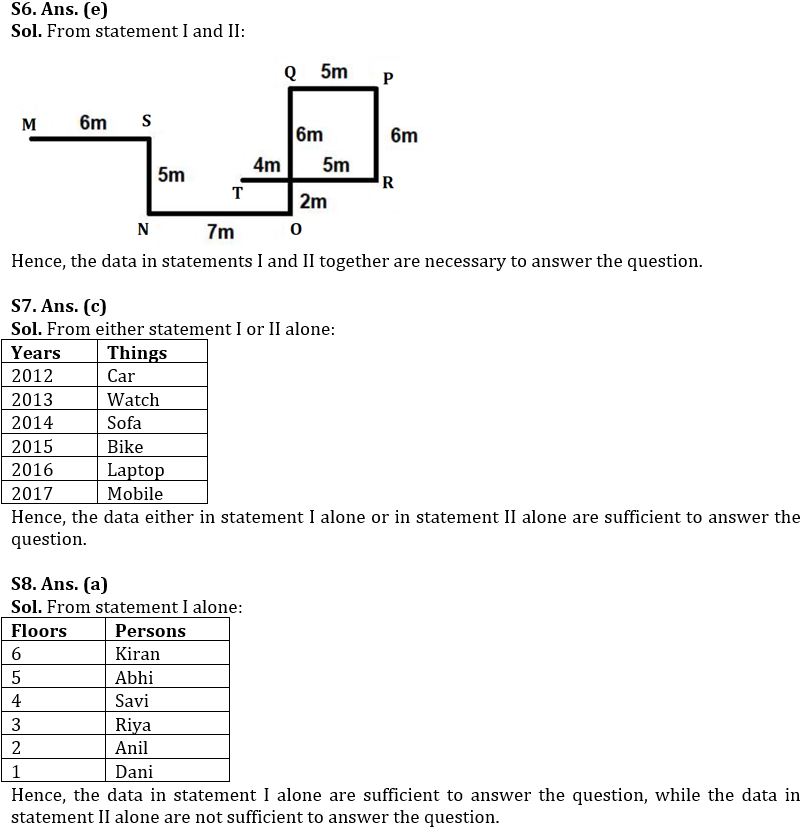
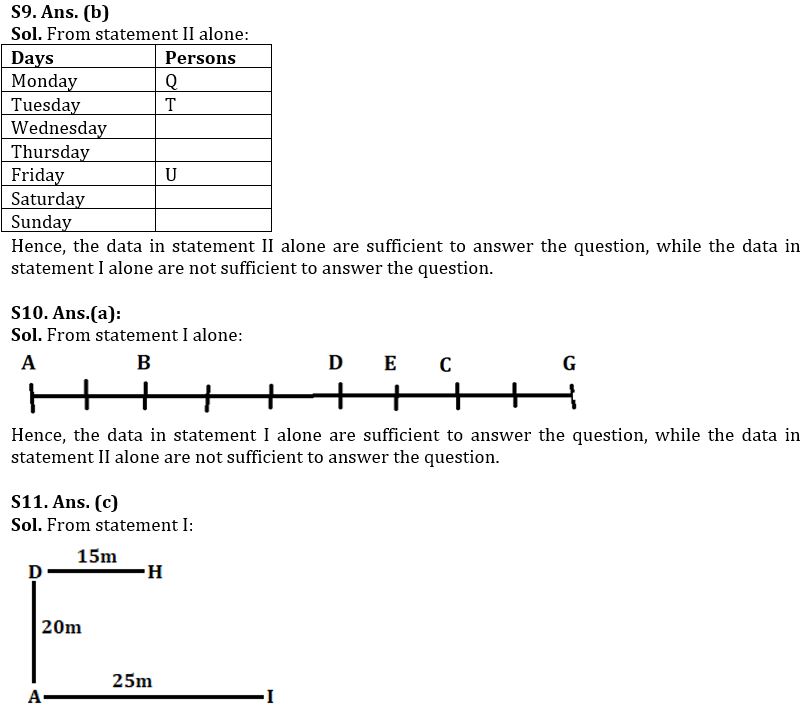
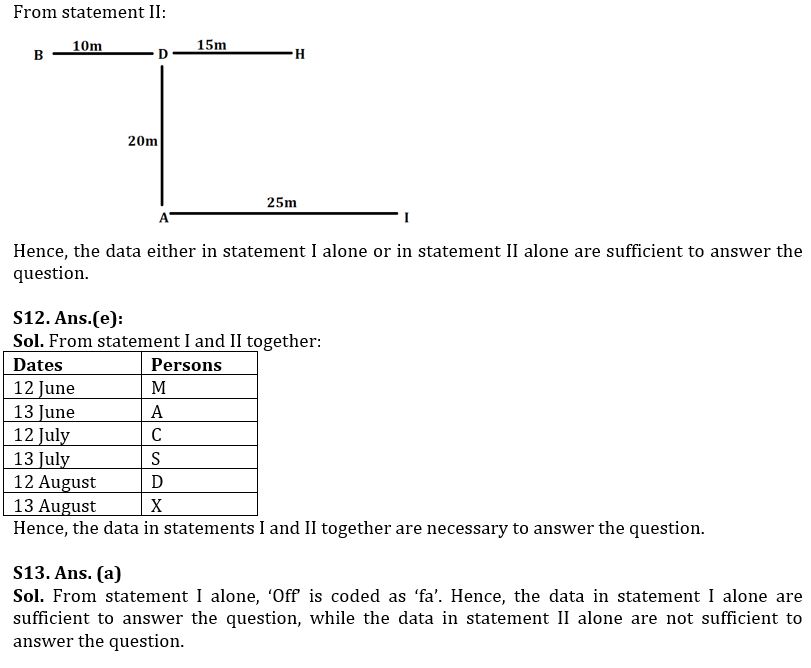
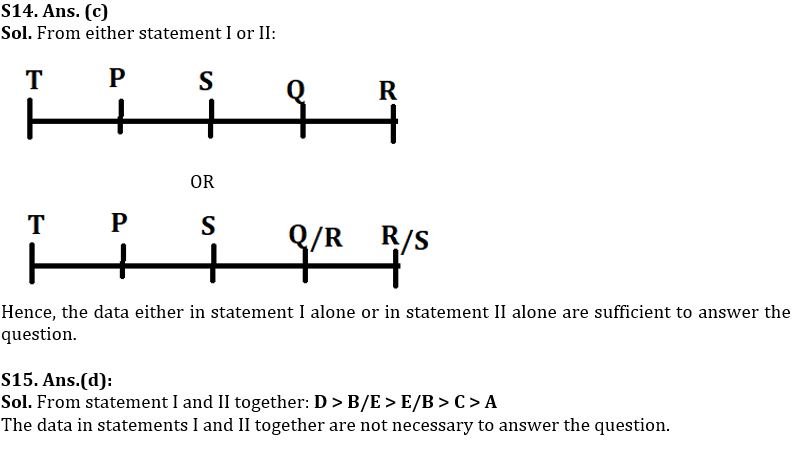


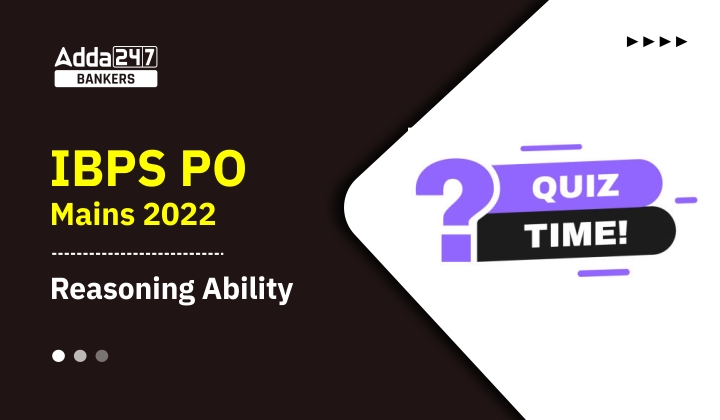
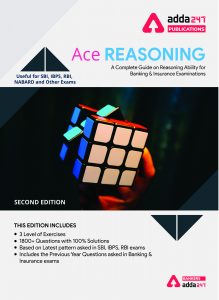

 50+ Data Sufficiency Questions For Bank ...
50+ Data Sufficiency Questions For Bank ...
 Quantitative Aptitude Quiz For Bank Main...
Quantitative Aptitude Quiz For Bank Main...


